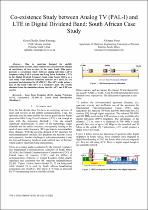 ResearchSpace
ResearchSpace
Coexistence study between Analog TV (PAL-I) and LTE in Digital Dividend band: South African case study
JavaScript is disabled for your browser. Some features of this site may not work without it.
- ResearchSpace
- →
- Research Publications/Outputs
- →
- Conference Publications
- →
- View Item
| dc.contributor.author |
Dludla, Angeline G

|
|
| dc.contributor.author |
Rananga, Seani

|
|
| dc.contributor.author |
Swart, A

|
|
| dc.date.accessioned | 2018-10-09T07:28:32Z | |
| dc.date.available | 2018-10-09T07:28:32Z | |
| dc.date.issued | 2018-08 | |
| dc.identifier.citation | Dludla, A.G., Rananga, S. and Swart, A. 2018. Coexistence study between Analog TV (PAL-I) and LTE in Digital Dividend band: South African case study. International Conference on Advances in Big Data, Computing and Data Communication Systems (icABCD 2018), Durban, South Africa, 6-7 August 2018 | en_US |
| dc.identifier.uri | https://ieeexplore.ieee.org/stamp/stamp.jsp?tp=&arnumber=8465438&tag=1 | |
| dc.identifier.uri | http://hdl.handle.net/10204/10452 | |
| dc.description | Paper presented at the International Conference on Advances in Big Data, Computing and Data Communication Systems (icABCD 2018), Durban, South Africa, 6-7 August 2018. | en_US |
| dc.description.abstract | Due to spectrum demand for mobile communication services, many studies has considered the impact of coexistence of two services in the same band. This paper presents a coexistence study between analog television (ATV) frequency using PAL-I systems and Long Term Evolution (LTE) in the digital dividend frequency band using South Africa as a case study. Four different scenarios between ATV and LTE are presented and simulated in SEAMCAT. The ATV as the primary user of the band while DTV is a secondary user. The results obtained from the simulation shows that the ATV and LTE can coexist. | en_US |
| dc.language.iso | en | en_US |
| dc.relation.ispartofseries | Worklist;21345 | |
| dc.subject | Analog Television | en_US |
| dc.subject | ATV | en_US |
| dc.subject | Coexistence | en_US |
| dc.subject | Guard Band Introduction | en_US |
| dc.subject | Long Term Evolution | en_US |
| dc.subject | LTE | en_US |
| dc.subject | SEAMCAT | en_US |
| dc.title | Coexistence study between Analog TV (PAL-I) and LTE in Digital Dividend band: South African case study | en_US |
| dc.type | Conference Presentation | en_US |
| dc.identifier.apacitation | Dludla, A. G., Rananga, S., & Swart, A. (2018). Coexistence study between Analog TV (PAL-I) and LTE in Digital Dividend band: South African case study. http://hdl.handle.net/10204/10452 | en_ZA |
| dc.identifier.chicagocitation | Dludla, Angeline G, Seani Rananga, and A Swart. "Coexistence study between Analog TV (PAL-I) and LTE in Digital Dividend band: South African case study." (2018): http://hdl.handle.net/10204/10452 | en_ZA |
| dc.identifier.vancouvercitation | Dludla AG, Rananga S, Swart A, Coexistence study between Analog TV (PAL-I) and LTE in Digital Dividend band: South African case study; 2018. http://hdl.handle.net/10204/10452 . | en_ZA |
| dc.identifier.ris | TY - Conference Presentation AU - Dludla, Angeline G AU - Rananga, Seani AU - Swart, A AB - Due to spectrum demand for mobile communication services, many studies has considered the impact of coexistence of two services in the same band. This paper presents a coexistence study between analog television (ATV) frequency using PAL-I systems and Long Term Evolution (LTE) in the digital dividend frequency band using South Africa as a case study. Four different scenarios between ATV and LTE are presented and simulated in SEAMCAT. The ATV as the primary user of the band while DTV is a secondary user. The results obtained from the simulation shows that the ATV and LTE can coexist. DA - 2018-08 DB - ResearchSpace DP - CSIR KW - Analog Television KW - ATV KW - Coexistence KW - Guard Band Introduction KW - Long Term Evolution KW - LTE KW - SEAMCAT LK - https://researchspace.csir.co.za PY - 2018 T1 - Coexistence study between Analog TV (PAL-I) and LTE in Digital Dividend band: South African case study TI - Coexistence study between Analog TV (PAL-I) and LTE in Digital Dividend band: South African case study UR - http://hdl.handle.net/10204/10452 ER - | en_ZA |





